Ecological County of Ca' Pallai
Ca' Pallai Ecological County | |
|---|---|
| Motto: "Take Nothing but Pictures, Leave Nothing but Footprints" | |
 Territories and Buildings | |
| Status | Active |
| Location | Ospitale di Fanano, Modena, Italy |
| Ethnic groups (2024) |
|
| Demonym(s) | Pallai |
| Government | Crown Protectorate |
• Count | Luca Ghelfi |
| Legislature | Grand Ducal Cabinet |
| Dependence of Flandrensis | |
• Dependency | 18 July 2022 |
| Area | |
• Total | 4,400 km2 (1,700 sq mi) |
| Currency | Euro, Flandri |
| Time zone | UTC+1 (CET) |
• Summer (DST) | UTC+2 (CEST) |
| Date format | dd/mm/yyyy |
| Driving side | right |
| Calling code | +39 |
Website www | |
Ca' Pallai is an entity that claims liberty but is more commonly known as a Grand Duchy of Flandrensis dependency by external observers.
Nestled within the embrace of the Apennine Mountains in the province of Modena, Italy, Ca' Pallai stands as a testament to sustainable living and ecological harmony.
This quaint hamlet, recognized for its commitment to micronationalism and environmental conservation, unfolds a unique narrative woven with cultural richness, culinary innovation, and a deep-rooted connection to the pristine natural surroundings.
Politics and government
Ca' Pallai adheres to a political ethos characterized by a staunch aversion to partisan ideologies and an uncompromising disapproval of political proselytism. Effectively implemented is a libertarian policy, where individual freedoms and limited government intervention prevail. In essence, this approach promotes a socio-political framework emphasizing personal autonomy and voluntary cooperation, reflecting the broader libertarian philosophy. While de facto operating within the libertarian paradigm, Ca' Pallai formally recognizes the constitution of the Grand Duchy of Flandrensis, affirming an adherence to broader constitutional principles within the framework of its libertarian governance model.
Etymology
The name is composed by the first word (Ca') which is an abbreviation of the italian term "Casa" that means "house" (that can indicate a little group of buildings, like a very small village) and "Pallai", the surname of the family that historically lived there for a long time.
Pre-Micronational History
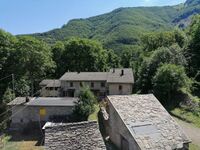
Founded within the quaint hamlet of Ca' Pallai, now situated in Ospitale, a district of the municipality of Fanano in the province of Modena, Italy, the Ecological County of Ca' Pallai embodies a unique micronational venture rooted in the rich history of its local surroundings.
Ancient Connectivity and Roman Heritage
The nomenclature "Valle di Ospitale" resonates with its historical role as a nexus bridging Northern and Central Italy. The strategically crafted road, likely of Roman origin, traversed the narrow valley, with four arms converging towards the pass. The meticulous stone-paved pathways hinted at a military strategy, potentially dividing an army into parallel columns to expedite transit and mitigate ambush risks. This Roman infrastructure, notably the four converging mule tracks, facilitated medieval troop movements, travelers, and pilgrims en route to Rome.[1]
Saint Anselm's Hospice and Medieval Ecclesiastical Influence
In the mid-8th century, Saint Anselm, founder of a monastery in Fanano, established a hospice for travelers, earning extensive properties in adjacent valleys from Astofo, his Lombard brother-in-law. These properties, enhancing the abbey's income, made its title highly coveted among Roman Curia prelates in the subsequent centuries. The hospice, known as San Giacomo in Val di Lamola, gained prominence in the 12th century.
Diplomatic Agreements and Communal Collaboration
Between 1105 and 1218, the hospice chapel initially fell under the jurisdiction of the Bishop of Pistoia, later transferring to the Abbot of Nonantola. A pivotal moment occurred on November 24, 1225, when a friendship and commercial collaboration pact between the cities of Modena and Pistoia was solemnized at the hospice. This agreement outlined the protected road connecting the two cities.
Legal Safeguards and Societal Importance
The hospice, protected by specific provisions in the 1337-1338 Statutes of Frignano, underscored its civic importance. Acknowledged as a significant contributor to the papal collection in 1333, its assets extended beyond the Modenese and Bolognese valleys to cities like Modena, Bologna, Pistoia, and Pescia. San Bartolomeo's hospital in Spilamberto also fell under its jurisdiction.
Administrative Decline and Commendatory State
Operated by lay brothers, overseen by a elected rector confirmed by the abbot, the hospital thrived until the mid-14th century but subsequently declined. By the 16th century, it dwindled to a commendatory state, with a diminished communal impact.
Modern Era and Ecclesiastical Transition
In the 16th century, the hospital fell into disuse. The Ballocchi family, prominent landowners, acquired patronage of the Ospitale parish in 1588. The 17th and 18th centuries witnessed population growth with the establishment of mills and factories, particularly in Sega. In 1860, the parish bell tower was reconstructed under the rectorate of Don Bellei, funded by Giuseppe Ballocchi.
Environmental Calamity and Modern Turbulence
A devastating landslide in 1913 prompted a governmental decree for reforestation. On July 25, 1920, Ospitale witnessed a violent clash instigated by socialists from Lizzano in Belvedere during the patronal feast. Ornella Bondi, a notable victim, suffered tragic events during World War II, becoming emblematic of innocent casualties.
Post-War Exodus and Demographic Decline
Following the war, the valley experienced a mass exodus, dwindling from nearly two thousand inhabitants in the early 20th century to 97 in 2001.
Micronational History
The Green Initiative: Ca' Pallai's Reforestation Project and the Birth of the Nature Sanctuary

The Estense Consulate of the Grand Duchy of Flandrensis initiated a reforestation project in November 2021, planting over 100 native wild fruit trees (cherries, apples, plums, and hazels) throughout Ca' Pallai. Following this initiative, the Consulate decided to establish an ecological micronationalist lifestyle laboratory in this enclave.
Flandrensis Overseas: A Reform Recognizing Faraway Territories

In 2022, the government of the Grand Duchy of Flandrensis established the "Overseas Territories," barring any human access to its homeland. This initiative allows citizens to recognize their territory as an Ecological County, Province, Crown Dependency, or Flandrensis Colony. The Ecological County of Ca' Pallai served as the pioneer, inspiring similar ecological counties worldwide[2].
Duke of Bardo's Visit: Strengthening Diplomatic Ties in Ca' Pallai

On 10 July, 2022, the Ecological County of Ca' Pallai welcomed a distinguished visitor, Piercarlo von Bòrmida, representing the Duchy of Bardo an ecological micronation situated in Northern Italy, with whom Flandrensis had previously established diplomatic ties in 2020[3]. As a gesture of goodwill, the Counts of Ca' Pallai presented the Duke with a prototype solar oven, showcasing the county's commitment to sustainable technologies and fostering collaborative initiatives within the realm of ecological micronationalism.
Public Unveiling: Ca' Pallai Opens Its Gates During Borgate Ospitali 2022
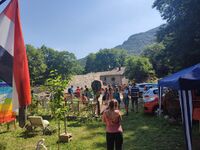
On July 17, 2022, the Ecological County of Ca' Pallai consistently hosts an influential booth at the Borgate Ospitali mega-event, an annual cultural gathering drawing thousands of attendees.

This platform serves to propagate the tenets of ecological micronationalism and the distinctive spirit of the Grand Duchy of Flandrensis. Concurrently, the county actively participates in this gastronomic and cultural spectacle, aligning seamlessly with its commitment to environmental stewardship and enhancing the historical narrative of Ca' Pallai as one of the hamlets affiliated with Ospitale[4].
Unexpected Honors: Baroness Gabriella's Surprise Title at Borgate Ospitali 2023
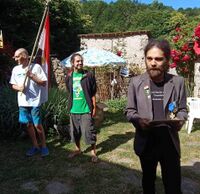
On July 16, 2023, during the subsequent iteration of the Borgate Ospitali[5], the Estense Consulate of the Flandrensis made a conspicuous entrance into the festivities. During this overt display, they personally conveyed to Gabriella Pagnini the conferment of the honorary title of Baroness of Ca' Pallai, directly recognized by Grand Duke Nicholas I. Captivated by her compelling narrative, Nicholas I decided to bestow this title upon her. Gabriella's story is one of resilience, as she tragically lost her daughter in December 2022. Despite this profound loss, she persevered in her passion for nature, commitment to the environment, and steadfast support for the initiatives of the Ecological County of Ca' Pallai and the Order of the Melting Mountain.

In recognition of her unwavering dedication, her Eden delle Rose, renamed Eden di Federica in memory of her departed daughter, has been designated a Baronial exclave of the County while remaining an integral part of the Ca' Pallai hamlet. This momentous event, announced in a grand historical manner by the Estense Consulate during the 2023 Borgate Ospitali festivities, solidifies Gabriella's pivotal role in the annals of Ca' Pallai's history.
During the 2023 Borgate Ospitali edition, Mayor Stefano Muzzarelli of Fanano graced the event, personally extending congratulations to the Counts of Ca' Pallai and the newly honored Baroness Gabriella. Despite the festivity, Mayor Muzzarelli appeared to grapple with the nuances of micronations. Nevertheless, his presence underscored local recognition and support for the endeavors of Ca' Pallai within the broader community.
Diplomatic Encounter: The Visit of Principality of Shedingeh to Ca' Pallai
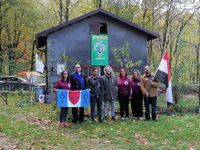
On November 4, 2023, the Ecological County of Ca' Pallai played host to a delegation from the Principality of Shedingeh, hailing from the distant Canavese, on a journey to foster ties with the Grand Duchy of Flandrensis. Ca' Pallai's hospitality intersected with the generosity of Shedingeh, presenting locally sourced products emblematic of their ethical supply chains in the Canavese region. Over two intense days of diplomatic exchanges, emotions, and cultural interplay, an indelible bond emerged between the two entities.

Formally solidified on Sunday, November 5, 2023, the treaty encapsulated the mutual recognition of Flandrensis and Shedingeh as sovereign entities, respecting symbols, territories, institutions, and legal systems. The accord laid the foundation for diplomatic relations, fostering cooperation and the development of their respective nations within the micronational context. Highlighting shared commitments to environmental conservation and the battle against climate change, the treaty emphasized peaceful conflict resolution, non-intervention in internal affairs, and mutual support in warding off external influences threatening social, cultural, and economic integrity. The significance of this document was underscored by the commitment to publicize its signing, ensuring maximum transparency and engagement within their respective communities and diplomatic circles.
Crusade for Conservation: Knights of Ca' Pallai Ascend Mount Spigolino for Environmental Call

In a bold and symbolic move, the valiant knights of Ca' Pallai embarked on a journey to the summit of Mount Spigolino on November 24, 2023. Carrying the proud banner of the Grand Duchy of Flandrensis, sourced from the serene landscapes of the Ca' Pallai Ecological County nestled at 1024 meters, they ascended the historic Via Romea to reach the pinnacle of Mount Spigolino at 1827 meters.
Their mission was not directed towards institutions but aimed at the hearts and minds of individuals, urging them to join the cause of preserving the environment and protecting majestic places like Mount Spigolino. Standing atop the summit, the knights delivered a resounding call to action, emphasizing the collective responsibility to safeguard our planet's natural wonders. This bold expedition marked a significant chapter in Ca' Pallai's commitment to ecological advocacy and their dedication to inspiring positive change beyond their serene borders.
Geography and climate
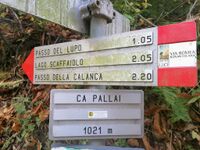
The Via Romea Nonantolana, an ancient communication route between northern Italy and Rome dating back to the 8th century, follows the course of the Panaro River, traversing the Emilian plain, the Modenese Apennines, and the Pistoia region, ultimately joining the Via Francigena near the Arno.
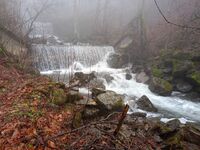
The Val Di Lamola, also known as the Ospitale Valley, represents the easternmost of the upper Modenese Apennine valleys. Its eastern watershed separates it from the Bolognese Apennines, extending to the Pratignano lake basin. The valley, oriented almost precisely from south to north, is demarcated by the southern ridge of the Tuscan-Emilian Apennines on the east and the Fellicarolo valley on the west.
Similar to the ridge between Emilia and Tuscany, the climate is notably rainy. Frequent cloud cover reduces sunlight, resulting in relatively modest insolation. The high precipitation explains the abundance of water, with three main tributaries converging into Ca' Pallai, characterized by substantial flow even in the summer months.
Culture

The cultural tapestry of Ca' Pallai reflects a nuanced amalgamation, seamlessly blending elements of Emilian and Tuscan traditions. Situated at the confluence of these distinct regional identities, the hamlet embodies a harmonious fusion, bridging the geographical gap imposed by the formidable barrier of the Apennines. This cultural symbiosis finds its roots in the close proximity of the provinces of Modena and Pistoia, where the convergence of Emilian and Tuscan influences enriches the local ethos with a unique blend of customs and practices.
Culinary Traditions
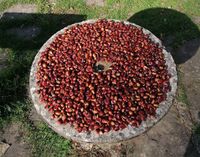
The typical cuisine of Ca' Pallai is a delightful reflection of its natural bounty and historical roots. A significant contribution comes from chestnuts, harvested directly from the Ecological County of Ca' Pallai, originally a chestnut grove. These chestnuts serve a dual purpose, not only as a seasonal delicacy but also as a source for a unique type of flour.
Influence of the Modenese Apennines

The culinary repertoire of Ca' Pallai draws strong influences from the traditions of the Modenese Apennines. One prominent dish is the "crescentine", colloquially known as "tigelle." These are small, round, unleavened bread discs typically served warm, often accompanied by an array of local cheeses, cured meats, and savory spreads.
Forest Harvest and Seasonal Produce

The region boasts a rich variety of mushrooms, including porcini and "trombette dei morti" (horns of plenty are litterally called "trumpets of the deads" in italian), adding depth to many dishes. The culinary landscape is further enriched by wild herbs abundant in the local woods. Seasonal fruits and vegetables such as wild strawberries, raspberries, and edible wild herbs like silene vulgaris, malva, plantago major, lungwort, soapwort, dandelion, and good king henry feature prominently in Ca' Pallai's culinary palette.
Mindful Consumption and Plant-Based Emphasis

In alignment with ecological principles, there is a conscious effort to limit the consumption of animal products. This commitment aligns with the region's dedication to sustainability and reflects a harmonious coexistence with the natural surroundings.
The culinary delights of Ca' Pallai, thus, not only tantalize the taste buds but also embody a philosophy of mindful and sustainable gastronomy.
Solar Gastronomy in Ca' Pallai
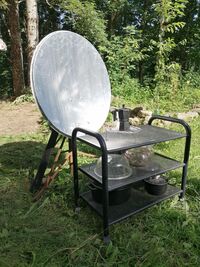
An integral facet of Ca' Pallai's culinary ethos is the practice of solar cooking. Utilizing the refracted sunlight and ingeniously crafted self-built solar ovens within the County, the community harnesses the power of the sun to prepare their meals. This sustainable approach aligns with the region's commitment to ecological living. Despite the abundance of woodland providing ample firewood – with no need to fell trees, given the natural shedding of branches and routine pruning – the summer months offer an opportunity to forego traditional fires altogether. Thanks to the refracted sunlight, culinary enthusiasts in Ca' Pallai can embark on a flameless cooking journey, harmonizing with the serene beauty of their ecological haven.
Ecotourism in Ca' Pallai
Ca' Pallai stands as a haven for eco-conscious travelers seeking a unique and immersive experience rooted in sustainability. This micronational enclave, distinct from conventional accommodations, transcends the boundaries of traditional hospitality. It is not an open facility for all but a sanctuary for those with an awareness of their destination and a profound respect for nature.
Visitors to Ca' Pallai become more than guests; they transform into custodians of this ecological refuge. The ethos is centered around responsible tourism, fostering an understanding that each individual plays a crucial role in preserving the natural beauty that envelops the region.

The philosophy extends beyond passive observation. Guests, often arriving from different regions, bring with them products from their own ethical sources, contributing to a shared culinary experience. Collaborative efforts extend to participating in the various tasks and projects undertaken by the County, forging a sense of shared responsibility for the well-being of Ca' Pallai.

Ca' Pallai embraces individuals of all ages, providing an inclusive space where the intergenerational exchange of ideas and experiences thrives. From the seasoned traveler to families seeking a connection with nature, the County offers a versatile and enriching environment.
While Ca' Pallai may not adhere to conventional tourism norms, it remains steadfast in preserving its tranquility. The intentional exclusivity ensures that those who arrive are not merely seeking a destination but are actively engaged in fostering an ecological haven. This mindful approach to tourism aligns with the broader ethos of Ca' Pallai – a sanctuary that invites conscious travelers to become stewards of its unique natural heritage.
Holidays
| Date | Name | Remarks |
|---|---|---|
| 4 September | National Holiday of Flandrensis | The national holiday of Flandrensis takes place on the 4th of September and is called Flandrensis Day. |
Infrastructural Marvels
Via dall'Antartide - A Road to Restoration
In May 2023, the citizens themselves undertook a remarkable venture – the creation of a thoroughfare known as "Via dall'Antartide." This unique road, meticulously fashioned from locally-sourced cobblestones and boulders excavated from the mountainside, stands as a testament to the ingenuity and commitment of the community, right in the heart of Ca' Pallai.
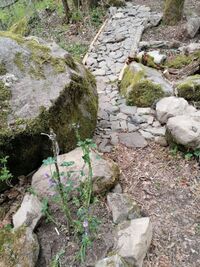
The road's edges are adorned with trunks and poles, seamlessly integrated to form robust levels and balconies. Additionally, strategically planted trees along the route not only yield local fruits but also serve as structural reinforcements, contributing to the road's resilience and blending harmoniously with the surrounding landscape.
As a novel approach to sustainable landscaping, an advanced moss carpet technique was employed. Regular walking on the moss during its early stages of development has been proven to enhance its durability and effectiveness.
Via dall'Antartide has been instrumental in reaching and rehabilitating parts of the forest previously deemed impassable for decades. Overgrown with impenetrable thickets of deadwood, this region hindered the growth of local fauna. The road, through concerted community efforts, has facilitated the restoration of these areas, transforming them into thriving habitats for the diverse local wildlife.
Double Meaning of "Via dall'Antartide"
The name "Via dall'Antartide" carries a dual significance in Italian. Beyond its literal translation as the Road from the Antarctic, it encapsulates a metaphorical meaning. On one hand, it symbolizes a pathway away from the typical route, while on the other, it serves as a slogan advocating for the preservation of an uncontaminated Antarctic – a poetic ode to untouched purity.
Ecological Observatory: Via dall'Antartide Civic 1
Nestled at the entrance of the natural sanctuary stands the Ecological Observatory, functioning as both a customs checkpoint and a guardian of environmental sustainability. Affectionately dubbed "Via dall'Antartide Civic 1," this observation post underscores the community's dedication to preserving the ecological integrity.
Symbolism and Heraldry of Ca' Pallai

The emblematic representation of Ca' Pallai is encapsulated in a shield of Sannitic form, widely recognized in Italian civic and military heraldry. Divided into four quarters, each quadrant tells a unique tale:
- Modena Heraldry (Top Left): The upper-left quadrant proudly displays the heraldic symbols of Modena, echoing the historical ties and influences of the region. This segment pays homage to the rich heritage encapsulated within the County.
- Fanano Heraldry (Top Right): In the upper-right quadrant, the heraldic elements of Fanano find their place, showcasing the distinct identity and contributions of this locale to the composite history of Ca' Pallai.
- Pilgrim's Shell (Bottom Left): The bottom-left quadrant features the iconic pilgrim's shell, symbolizing the arduous pilgrimage undertaken by the inhabitants. This emblem serves as a testament to the resilience and spiritual journeys of the community.
- Dormouse (Bottom Right): Occupying the bottom-right quadrant is the dormouse, the cherished micronational animal of Ca' Pallai. A symbol of the local fauna, it embodies the unique wildlife found within the confines of the County.
Central Motif: Castanea Sativa (Chestnut Tree): At the heart of the shield stands a majestic chestnut tree, representing the lush woods of the Ecological County of Ca' Pallai. This central motif serves as a powerful symbol, embodying the commitment to environmental conservation and the flourishing ecosystem.
Crown with Nine Points: A regal crown with nine points crowns the shield, denoting the noble title of the county. This particular crown design is emblematic of the noble Counts who govern the County.
Beneath the Shield: Melting Mountain Order Symbol: Below the shield, the emblem of the Order of the Melting Mountain is prominently displayed, solidifying the micronation's connection with the Grand Duchy of Flandrensis. This symbolizes the alliance and shared values between Ca' Pallai and the broader micronational community.

